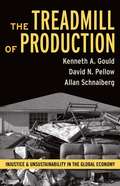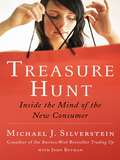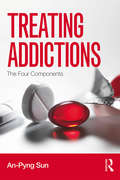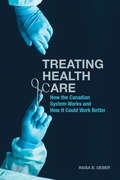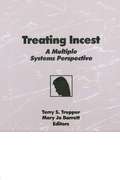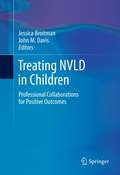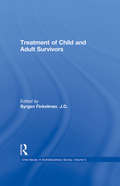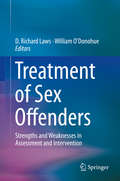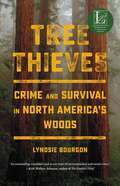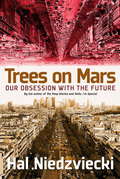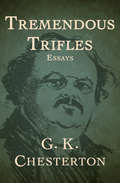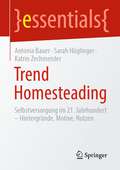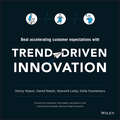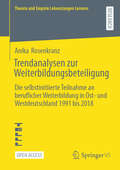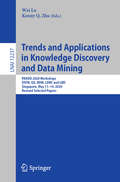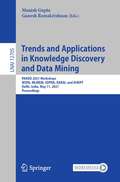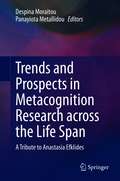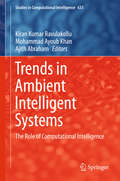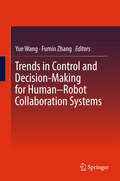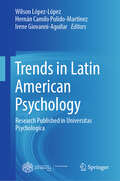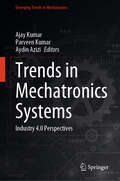- Table View
- List View
Treadmill of Production: Injustice and Unsustainability in the Global Economy
by Kenneth A. Gould David N. Pellow Allan SchnaibergSchnaiberg's concept of the treadmill of production is arguably the most visible and enduring theory to emerge in three decades of environmental sociology. Elaborated and tested, it has been found to be an accurate predictor of political-economic changes in the global economy. In the global South, it has figures prominently in the work of structural environmental analysts and has been used by many political-economic movements. Building new extensions and applications of the treadmill theory, this new book shows how and why northern analysts and governments have failed to protect our environment and secure our future. Using an empirically based political-economic perspective, the authors outline the causes of environmental degradation, the limits of environmental protection policies, and the failures of institutional decision-makers to protect human well-being.
Treasure Hunt
by Michael J. Silverstein John ButmanTwo essential business books in a handsome gift set In his consulting with dozens of leading companies, Michael J. Silverstein has interviewed thousands of consumers about what really drives their purchase decisions. His first book (with Neil Fiske), the acclaimed bestseller Trading Up, has taught a generation of marketers about the new luxury phenomenon. It explains why people happily pay a steep premium for goods and services that are emotionally satisfying, from cars to golf clubs to beauty products? and how smart companies are meeting their needs. His second book, Treasure Hunt, explores how the same middle-class people who are trading up at Victoria's Secret and Panera are going on treasure hunts at Costco and Home Depot. And why they are often getting as much emotional satisfaction in the discount stores as in the luxury stores. Both books are written with a unique blend of hard data and personal stories. Now they are available together as a specially priced boxed set. BACKCOVER: ?Trading Up is ? packed with insights on how shoppers think and behave. I found it incredibly smart and illuminating. ' ?David Brooks, author of Bobos in Paradise ?There is a treasure trove of premium advice and valuable information in Treasure Hunt for anyone in any business who wants to cash in on the trading up/trading down trend and avoid getting mired in the dwindling profit margins of the middle. ' ?Cecil Johnson, Knight Ridder News Service
Treated Like Family: How an Entrepreneur and His "Employee Family" Built Sargento, a Billion-Dollar Cheese Company
by Tom FaleyAt the age of nineteen, high school diploma in hand, Leonard Gentine knew two things: he wanted to own a family business that would pass from generation to generation, and he wanted to spend the rest of his life with Dolores Becker, a girl he'd met on a blind date.For Leonard, life didn't prove that simple.This biography, told from the viewpoint of four generations of the Gentine family, places the reader in Leonard's shoes as he advances from young man to old age and discovers life's foundational lessons. Along the way, he endures outstanding debts, disappointments, and a collection of small businesses, all with Dolores at his side. It's an inspirational story of perseverance, personal integrity, and a mind-set of always doing the right thing-as painful as that may be in the short term.Treated Like Family details the development of Sargento-a nationally recognized cheese company and household name. At the same time, it's a timeless story that showcases the importance of the individual and how a family united in a single purpose within the right culture is unstoppable.Tom Faley invites the reader into the lives of the Gentine family and the men and women they hired, deftly weaving a story grounded in over 180 interviews-the collective voices of the company's employees, retirees, and friends.Treated Like Family offers a rare glimpse into the creative mind of an innovator and entrepreneur and underscores the rewards for all of us when we maintain our humanity toward one another: When one person motivates others to pull together, at times facing unspeakable odds, he is able not only to change their lives but to alter history.
Treating Addictions: The Four Components
by An-Pyng Sun<i>Treating Addictions: The Four Components</i> offers a unique and coherent understanding of addiction. The book begins with a chapter discussing the framework of addiction and the four essential components of treatments—the fundamentals of addiction, co-occurring disorders, quality of life, and macro factors—and subsequent chapters elaborate on each component. Most currently available addiction treatment books present knowledge and skills in separate chapters and fail to integrate all chapters within a single framework that can weave all concepts into a meaningful tapestry. Using a unified framework, this book offers students a comprehensive skill set for treating addictions.
Treating Health Care: How the Canadian System Works and How It Could Work Better
by Raisa DeberCanada has been among the world leaders in recognizing the multiple factors that impact health. Focusing on Canada’s health care system, Raisa B. Deber provides brief descriptions of some key facts and concepts necessary to understand health care policy in Canada and place it in an international context. An accessible guide, Treating Health Care unpacks key concepts to provide informed discussions that help us understand and diagnose Canada’s health care system and to clarify which proposed changes are likely to improve it - and which are not. This book provides background information to clarify such concepts as: determinants of health; how health systems are organized and financed (including international comparisons); health economics; health ethics; and roles and responsibilities of different stakeholders, including government, providers, and patients. It then addresses some key issues, including equity, efficiency, access and wait times, quality improvement and patient safety, and coverage and payment models. Using analysis rather than advocacy, Deber provides a toolkit to help understand health care and health policy.
Treating Incest: A Multiple Systems Perspective
by Mary Jo Barrett Terry S TrepperThis timely book provides for the therapist working with cases of intrafamily child sexual abuse both a theoretical background and practical information for the treatment of incest and gives new insight into the complex problems associated with incest. With the enactment of more stringent child abuse reporting laws nationwide and increased public education about the problem, there has been a dramatic increase in the need for incest-related psychotherapy. Treating Incest is an important source of information about the assessment and treatment of the family that will enable clinicians to provide appropriate crisis intervention for families and make informed judgments about referrals, if necessary. The book&’s central theme is that effective treatment of incest requires a systemic approach because incestuous activity is the product of a problematic family, rather than the cause. The book is divided into two helpful sections: assessment issues and treatment issues and techniques.
Treating NVLD in Children
by John M. Davis Jessica BroitmanChildren with nonverbal learning disabilities (NVLD) have needs that can take many forms and may, over time, require consultation and collaboration with professionals from several fields. Given that multiple specialists may be involved in working with children with NVLD - as well as the array of treatment variables - even seasoned practitioners may find themselves in confusing situations. Treating NVLD in Children takes a developmental view of how the problems and needs of young people with nonverbal learning disabilities evolve and offers a concise guide for professionals who are likely to contribute to treatment. Expert practitioners across specialties in psychology, education, and rehabilitative therapy explain their roles in treatment, the decisions they are called on to make, and their interactions with other professionals. Collaborative interventions and teamwork are emphasized, as are transitions to higher learning, employment, and the adult world. Among the book's key features are: A new four-subtype model of NVLD, with supporting research.A brief guide to assessment, transmitting results, and treatment planning.Chapters detailing the work of psychologists, therapists, coaches, and others in helping children with NVLD.Material specific to improving reading, writing, and mathematics. Overview of issues in emotional competency and independent living. An instructive personal account of growing up with NVLD. Treating NVLD in Children: Professional Collaborations for Positive Outcomes is a key resource for a wide range of professionals working with children, including school and clinical child psychologists; educational psychologists and therapists; pediatricians; social workers and school counselors; speech and language therapists; child and adolescent psychiatrists; and marriage and family therapists.
Treatment of Child and Adult Survivors (Child Abuse: A Multidisciplinary Survey #5)
by J. D. Byrgen FinkelmanFirst published in 1995. Routledge is an imprint of Taylor & Francis, an informa company.
Treatment of Offenders and Families (Child Abuse: A Multidisciplinary Survey #Vol. 6)
by J. D. Byrgen FinkelmanFirst Published in 1995. Routledge is an imprint of Taylor & Francis, an informa company.
Treatment of Sex Offenders
by D. Richard Laws William O'DonohueThis rigorous survey offers a comprehensive rethinking of the assessment and treatment of sexual offenders for a bold challenge to practitioners. It critiques what we understand about offenders and the mechanisms of offending behaviors, and examines how this knowledge can best be used to reduce offending and relapses. To this end, experts weigh the efficacy of common assessment methods and interventions, the value of prevention programs, and the validity of the DSM's classifications of paraphilias. This strengths/weaknesses approach gives professional readers a guide to the current state as well as the future of research, practice, and policy affecting this complex and controversial field. Included in the coverage: Strengths of actuarial risk assessment. Risk formulation: the new frontier in risk assessment and management. Dynamic risk factors and offender rehabilitation: a comparison of the Good Lives Model and the Risk-Need-Responsivity Model. The best intentions: flaws in sexually violent predator laws. Desistance from crime: toward an integrated conceptualization for intervention. From a victim/offender duality to a public health perspective. A call to clear thought and accurate action, Treatment of Sex Offenders will generate discussion and interest among forensic psychologists, psychiatrists, clinical psychologists, and social workers.
Tree Thieves: Crime and Survival in North America's Woods
by Lyndsie BourgonSHORTLISTED FOR THE COLUMBIA SCHOOL OF JOURNALISM J. ANTHONY LUKAS BOOK AWARD LONGLISTED FOR THE 2023 PEN/JOHN KENNETH GALBRAITH AWARD FOR NONFICTION FINALIST FOR THE NELLIE BY CHANTICLEER INTERNATIONAL BOOK AWARDS FOR JOURNALISTIC NON-FICTION A gripping investigation of the billion-dollar timber black market &“and a fascinating examination of the deep and troubled relationship between people and forests&” (Michelle Nijhuis, author of Beloved Beasts). There's a strong chance that chair you are sitting on was made from stolen lumber. In Tree Thieves, Lyndsie Bourgon takes us deep into the underbelly of the illegal timber market. As she traces three timber poaching cases, she introduces us to tree poachers, law enforcement, forensic wood specialists, the enigmatic residents of former logging communities, environmental activists, international timber cartels, and indigenous communities along the way. Old-growth trees are invaluable and irreplaceable for both humans and wildlife, and are the oldest living things on earth. But the morality of tree poaching is not as simple as we might think: stealing trees is a form of deeply rooted protest, and a side effect of environmental preservation and protection that doesn't include communities that have been uprooted or marginalized when park boundaries are drawn. As Bourgon discovers, failing to include working class and rural communities in the preservation of these awe-inducing ecosystems can lead to catastrophic results. Featuring excellent investigative reporting, fascinating characters, logging history, political analysis, and cutting-edge tree science, Tree Thieves takes readers on a thrilling journey into the intrigue, crime, and incredible complexity sheltered under the forest canopy.
Trees on Mars
by Hal NiedzvieckiThe future is big right now--for perhaps the first time, our society is more focused on what is going to happen in the future than what is happening right now. In Trees on Mars: Our Obsession with the Future, cultural critic and indie entrepreneur Hal Niedzviecki asks how and when we started believing we could and should "create the future." What is it like to live in a society utterly focused on what is going to happen next? Through visits to colleges, corporations, tech conferences, factories and more, Niedzviecki traces the story of how owning the future has become irresistible to us. In deep conversation with both the beneficiaries and victims of our relentless obsession with the future, Niedzviecki asks crucial questions: Where are we actually heading? How will we get there? And whom may we be leaving behind?nce-bucolic industry, to a group of Stanford undergraduates pulling all-nighters in an effort to produce the next must-have app, to a Michigan teacher struggling to integrate mandatory iPad use into her third-grade curriculum, and to a recently laid off auto worker being sent to state-sponsored retraining. Through these characters and others, Niedzviecki shows how future-obsession and future-anxiety are affecting real people.
Tremendous Trifles: Essays
by G. K. ChestertonAn entertaining collection drawn from G. K. Chesterton's early years as a newspaper columnist This compilation of "fleeting sketches," written by G. K. Chesterton while he was a columnist for the Daily News, contains the humor, foresight, and intellectual curiosity that quickly made the young writer a household name throughout London. A tribute to the playfulness of Chesterton's spirit, Tremendous Trifles contains such gems as "An Accident," in which the author crashes an omnibus into a hansom cab, and "The Advantages of Having One Leg," a charmingly thorough investigation of optimism and pessimism. Fans of Chesterton's most famous works--from the Father Brown Stories to Heretics and Orthodoxy--will delight in the cleverness and invigorating wit of Tremendous Trifles. This ebook has been professionally proofread to ensure accuracy and readability on all devices.
Trend Homesteading: Selbstversorgung im 21. Jahrhundert – Hintergründe, Motive, Nutzen (essentials)
by Antonia Bauer Sarah Höglinger Katrin ZechmeisterHomesteading ist ein Trend aus den Vereinigten Staaten, bei dem die Selbstversorgung mit Nahrungsmitteln im Vordergrund steht. Für die Erhaltung der Gesundheit sind Lebensmittel ein wesentlicher Einflussfaktor, wobei deren Qualität eine wichtige Rolle spielt. Darüber hinaus zeigt sich, dass die Wertschätzung gegenüber Lebensmitteln in den letzten Jahren gesunken ist. Dieser Verlust der Wertschätzung führte allerdings zu einer Trendwende im Konsumverhalten in Bezug auf Herkunft, Anbauarten und Saisonalität. Dieses Buch zeigt, dass die COVID-19-Pandemie mit ein Beweggrund war, der viele Menschen zum Umdenken angeregt und die Motivation hervorgerufen hat, Lebensmittel verstärkt selbst anzubauen, zu konservieren und zu verarbeiten.
Trend-Driven Innovation
by Alexander Osterwalder Henry Mason David Mattin Delia Dumitrescu Maxwell LuthyTrend-Driven InnovationBeat accelerating customer expectations.Every business leader, entrepreneur, innovator, and marketer wants to know where customers are headed. The problem? The received wisdom on how to find out is wrong.In this startling new book, the team at TrendWatching share a powerful, counter-intuitive truth: to discover what people want next, stop looking at customers and start looking at businesses. That means learning how to draw powerful insights from the way leading brands and disruptive startups--from Apple to Uber, Chipotle to Patagonia--redefine customer expectations.Sharing the secrets that have led thousands of the world's most successful brands and agencies to rely on TrendWatching for over a decade, Trend-Driven Innovation is the book that will reconfigure your view of the business world forever. You'll learn: How to spot emerging trends using three crucial building blocks, and how to recognize the expectation gaps that herald opportunity. Why most professionals focus on precisely the wrong trends and innovations, and how to avoid this. How to turn trends and insights into innovations that customers will love. Amid the endless change that defines today's business environment, opportunity is everywhere. Highly practical, and featuring real-world examples from around the world, Trend-Driven Innovation is the actionable, battle-tested manual that will enable you harness those opportunities time after time. Setting you up to build an organization that matters, products customers lust after, and campaigns people can't stop talking about.
Trendanalysen zur Weiterbildungsbeteiligung: Die selbstinitiierte Teilnahme an beruflicher Weiterbildung in Ost- und Westdeutschland 1991 bis 2018 (Theorie und Empirie Lebenslangen Lernens)
by Anika RosenkranzIn diesem Open-Access-Buch wird untersucht, welche Muster bzw. Veränderungen der selbstinitiierten Teilnahme an beruflicher Weiterbildung sich im Trend identifizieren lassen. Bisherige Analysen, die die Teilnahme Beschäftigter an beruflicher Weiterbildung differenziert nach Ost- und Westdeutschland im Trend betrachtet haben, verweisen auf regionalspezifische Muster. Diese Unterschiede werden punktuell vor dem Hintergrund ost-west-spezifischer Arbeitsmarktkontexte verortet, oft jedoch findet keine Kontextualisierung statt. Inwieweit ost-west-spezifische Entwicklungen der Berufs- und Arbeitsmarktstrukturen Einfluss auf motivationale Aspekte der Teilnahmeentscheidung Beschäftigter nehmen, stand bisher nicht im Fokus. Die vorliegende Arbeit untersucht daher die Teilnahmeselektivität Beschäftigter an selbstinitiierter beruflicher Weiterbildung vor dem Hintergrund ost-west-spezifischer Entwicklungen der Berufs- und Arbeitsmarktstrukturen. Angesichts sich verändernder Kontexte lassen sich veränderte Muster der Teilnahme im Zeitverlauf beobachten. Die Befunde verweisen zudem auf regionale Strukturdifferenzen, die Einfluss auf die selbstinitiierte Teilnahme an beruflicher Weiterbildung nehmen. Insgesamt zeigt sich eine für ostdeutsche Beschäftigte verringerte Teilnahmequote im Vergleich zu westdeutschen Beschäftigten.
Trends and Applications in Knowledge Discovery and Data Mining: PAKDD 2020 Workshops, DSFN, GII, BDM, LDRC and LBD, Singapore, May 11–14, 2020, Revised Selected Papers (Lecture Notes in Computer Science #12237)
by Wei Lu Kenny Q. ZhuThis book constitutes the thoroughly refereed post-workshop proceedings of the workshops that were held in conjunction with the 24th Pacific-Asia Conference on Knowledge Discovery and Data Mining, PAKDD 2020, in Singapore, Singapore, in May 2020. The 17 revised full papers presented were carefully reviewed and selected from a total of 50 submissions. The five workshops were as follows: · First International Workshop on Literature-Based Discovery (LBD 2020) · Workshop on Data Science for Fake News (DSFN 2020)· Learning Data Representation for Clustering (LDRC 2020)· Ninth Workshop on Biologically Inspired Techniques for Data Mining (BDM· 2020)· First Pacific Asia Workshop on Game Intelligence & Informatics (GII 2020)
Trends and Applications in Knowledge Discovery and Data Mining: PAKDD 2021 Workshops, WSPA, MLMEIN, SDPRA, DARAI, and AI4EPT, Delhi, India, May 11, 2021 Proceedings (Lecture Notes in Computer Science #12705)
by Manish Gupta Ganesh RamakrishnanThis book constitutes the refereed proceedings of five workshops that were held in conjunction with the 25th Pacific-Asia Conference on Knowledge Discovery and Data Mining, PAKDD 2021, in Delhi, India, in May 2021. The 17 revised full papers presented were carefully reviewed and selected from a total of 39 submissions.. The five workshops were as follows: Workshop on Smart and Precise Agriculture (WSPA 2021) PAKDD 2021 Workshop on Machine Learning for Measurement Informatics (MLMEIN 2021) The First Workshop and Shared Task on Scope Detection of the Peer Review Articles (SDPRA 2021) The First International Workshop on Data Assessment and Readiness for AI (DARAI 2021) The First International Workshop on Artificial Intelligence for Enterprise Process Transformation (AI4EPT 2021)
Trends and Determinants of Healthy Aging in China
by Yi Zeng Xiaoyan Lei Jiehua Lu Xiaoming ShiThis book studies healthy aging in China based on analyses of the datasets of eight waves of longitudinal survey in 1998-2018 with worldwide largest sample of oldest-old. It consists of four parts. The first part reports the 6th, 7th, and 8th surveys of “Chinese Longitudinal Healthy Longevity Survey” (CLHLS), with the largest sample of oldest-old aged 80+ in the world and comparable sample of young-old aged 65–79, trends and characteristics of physical health and mental health of older adults in China based on analyses of the CLHLS datasets. The second part focuses on analyses and discussions of the influencing factors of healthy aging from perspectives of families, socioeconomics and community environments. The third part reports studies on the gender and age differences in main chronic diseases’ prevalence rates, inflammation, anti-oxidation, trace elements, effects of the nutritional dietary structure and the environmental selenium on health among the older adults. The fourth part focuses on the analyses and discussions of policy recommendations to face the serious challenges of the population aging in China and the database of the eight waves of CLHLS from 1998 to 2018, which are available free of charge to scholars, practitioners and general public for scientific research and socioeconomic planning. This book is easy to read and to understand by researchers and the general public, and no special professional background is required.
Trends and Factors in Japan's Long-Term Care Insurance System
by Pedro Olivares-Tirado Nanako TamiyaAgeing population poses a set of complex policy and dilemmas for social security systems, intensifying the concerns about rising expenditures in health care and long-term care for elderly. In this context, ageing societies has many valuable lessons to learn by studying Japan's experience dealing with its hyper-aged society and particularly from its strategies to ensure the financial sustainability of the Long-Term Care Insurance (LTCI) system. Based on an exhaustive literature review, and the results from six original researches on long-term care expenditures in Japan (LTCE) conducted during a doctoral program, the book provides a comprehensive view in analyzing trends and factors associated with increasing expenditures in the Long-Term Care Insurance system in Japan. The book address relevant topics such as; the main socio-demographic changes experienced by the Japanese society during the last three decades, predictors of the LTCE, measuring efficiency in nursing homes, the impact of the LTCI 2005-reform to contain expenditures, cost-effectiveness of the in-home and community based services and institutional LTCE in the last year of life. The book end with a discussion on futures challenges and strategies oriented to contribute with the sustainability of LTCI system in Japan.
Trends and Prospects in Metacognition Research across the Life Span: A Tribute to Anastasia Efklides
by Despina Moraitou Panayiota MetallidouThis volume brings together trends and their prospects to understand the complexity of metacognitive phenomena, with emphasis on the interactions of metacognition with affect. It discusses the three perspectives in understanding these interactions: the possible mechanisms underlying them, the manifestation of interactions of metacognition with affect in self- and co-regulation in social and educational contexts, and changes during development in young children and older adults. This volume is a tribute to Professor Emerita Anastasia Efklides, who was among the pioneers to investigate and argue the importance of the interactions between metacognition and affect. It serves as a dedication to her contribution in the widening of the scope of research in metacognition and self-regulated learning.
Trends in Ambient Intelligent Systems
by Ajith Abraham Mohammad Ayoub Khan Kiran Kumar RavulakolluThis book demonstratesthe success of Ambient Intelligence in providing possible solutions for the dailyneeds of humans. The book addresses implications of ambient intelligence in areasof domestic living, elderly care, robotics, communication, philosophy andothers. The objective of this editedvolume is to show that Ambient Intelligence is a boon to humanity withconceptual, philosophical, methodical and applicative understanding. The book also aims to schematicallydemonstrate developments in the direction of augmented sensors, embeddedsystems and behavioral intelligence towards Ambient Intelligent Networks orSmart Living Technology. It contains chapters in the field of AmbientIntelligent Networks, which received highly positive feedback during the reviewprocess. The book contains research work, with in-depth state of the art fromaugmented sensors, embedded technology and artificial intelligence along withcutting-edge research and development of technologies and applications of AmbientIntelligent Networks. This book is intended to introduce ideas, methods,technologies of the future development of humanity, Science and Technology.
Trends in Control and Decision-Making for Human–Robot Collaboration Systems
by Yue Wang Fumin ZhangThis book provides an overview of recent research developments in the automation and control of robotic systems that collaborate with humans. A measure of human collaboration being necessary for the optimal operation of any robotic system, the contributors exploit a broad selection of such systems to demonstrate the importance of the subject, particularly where the environment is prone to uncertainty or complexity. They show how such human strengths as high-level decision-making, flexibility, and dexterity can be combined with robotic precision, and ability to perform task repetitively or in a dangerous environment. The book focuses on quantitative methods and control design for guaranteed robot performance and balanced human experience from both physical human-robot interaction and social human-robot interaction. Its contributions develop and expand upon material presented at various international conferences. They are organized into three parts covering: one-human-one-robot collaboration; one-human-multiple-robot collaboration; and human-swarm collaboration. Individual topic areas include resource optimization (human and robotic), safety in collaboration, human trust in robot and decision-making when collaborating with robots, abstraction of swarm systems to make them suitable for human control, modeling and control of internal force interactions for collaborative manipulation, and the sharing of control between human and automated systems, etc. Control and decision-making algorithms feature prominently in the text, importantly within the context of human factors and the constraints they impose. Applications such as assistive technology, driverless vehicles, cooperative mobile robots, manufacturing robots and swarm robots are considered. Illustrative figures and tables are provided throughout the book. Researchers and students working in controls, and the interaction of humans and robots will learn new methods for human-robot collaboration from this book and will find the cutting edge of the subject described in depth.
Trends in Latin American Psychology: Research Published in Universitas Psychologica
by Wilson López-López Hernán Camilo Pulido-Martínez Irene Giovanni-AguilarThis book brings together English versions of a selection of articles originally published in Spanish in Universitas Psychologica, one of the most important psychology journals in Latin America. It&’s an anthology of theoretical and research papers published by important Latin American psychologists that aim to provide the international community with a representative sample of research trends in Latin American psychology in different subfields. This anthology is organized in three parts, each one containing a selection of articles from different subfields of psychological research and practice. The first part brings together papers in the fields of social and community psychology, two areas in which Latin American psychologists have developed quite original contributions to research and practice. The second part is dedicated to articles showcasing research conducted with Latin American children and youth in the fields of educational, cognitive and developmental psychology. Finally, the third part highlights articles that present contributions of research in fields such as neuropsychology, clinical and health psychology to the improvement of mental and physical health care of the Latin American population. Each part starts with an introduction especially written by the volume editors for this anthology. Trends in Latin American Psychology: Research Published in Universitas Psychologica will be of interest to researchers in many subfields of psychology, especially to those interested in international and cross-cultural psychology, as the book offers a significative sample of the best research done by Latin American psychologists. The translation of the original articles in Spanish into English was done with the help of artificial intelligence. A subsequent human revision was done primarily in terms of content.
Trends in Mechatronics Systems: Industry 4.0 Perspectives (Emerging Trends in Mechatronics)
by Ajay Kumar Aydin Azizi Parveen KumarThis book consists of twelve chapters covering the design aspects, their feasibility, mathematical modeling by numerical, experimental, computational and simulation approaches. It discusses how different internet technologies integrate mechatronics systems with people, products and complex systems. The methodology and tools included in this book focus on contemporary aspects of integrating Industry 4.0 and mechatronics systems for new means and models to achieve a sustainable green environment. Readers will get an insight into the current development of mechatronics systems in the context of scientific disciplines and present new results of research and development, indicating the trends of development in this interdisciplinary field.
